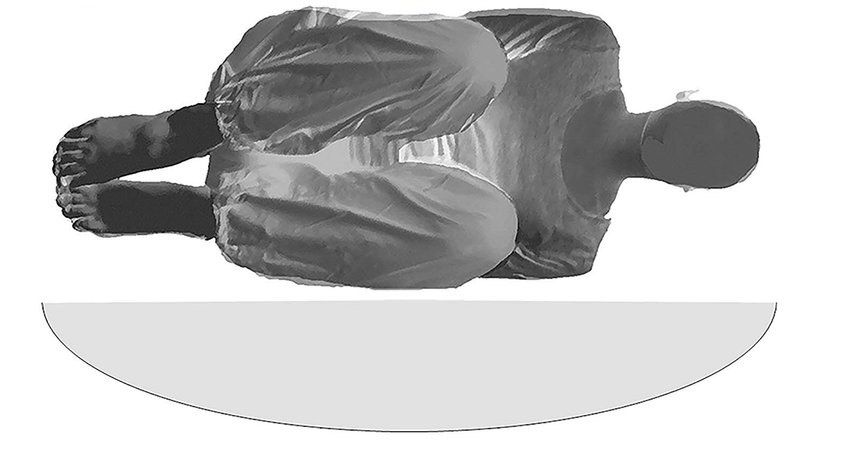Archaeologists Identify Oldest Known Human Burial in Lower Central America
The unusually muscular young woman was buried in what is now Nicaragua nearly 6,000 years ago
/https://tf-cmsv2-smithsonianmag-media.s3.amazonaws.com/filer/4b/9d/4b9dd759-b8fc-4ce7-bf06-b6573159fd31/excavation1.jpg)
Some 5,900 years ago, a young woman was buried in a shallow pit in Central America. Laid on her back with legs tucked against her chest and arms prone at the sides of her body, she remained undisturbed for nearly six millennia. All the while, her remains were shielded from the Caribbean’s tropical conditions by an ancient shell mound—essentially a pile of assorted shells designed to mark burial sites or certain spots in the landscape—that had been erected atop her grave.
Now, Laura Geggel reports for Live Science, a team of Canadian, German and Nicaraguan researchers has deemed her final resting site, located in what is now the Nicaraguan village of Bleera Kaanu, the oldest known human buried in lower Central America to date, adding a significant chapter to the region’s archaeological record. As the group writes in a study published in the journal Antiquity, the find “represents an important contribution to our understanding of the early peopling” of the Caribbean.
Bleera Kaanu’s archaeological base, known officially as the Angi shell-matrix site, was first excavated in the 1970s, according to David Ruiz Marull of La Vanguardia. It wasn’t until recently, however, that researchers finally unearthed the woman’s grave.
Ancient human remains are rarely found in lower Central America and similarly tropical regions, as acidic soil tends to damage bone. Luckily, lead author Mirjana Roksandic, an anthropologist at Canada’s University of Winnipeg, tells Live Science’s Geggel, the shell mound placed over the woman’s grave “reduced the acidity of the soil and helped preserve the remains.”
In the study, the authors note that the woman was still in her original burial position when the grave was reopened. Although the skeleton was largely complete, the quality of the bones was compromised by the Caribbean’s poor preservation conditions.

Forensic analysis suggested the ancient subject died when she was between 25 and 40 years old. Despite the heavy wear evident on her teeth (a marker usually associated with higher age), the researchers believe she was closer to the lower limit of this age range, as individuals who follow a seafood-based diet tend to exhibit poorer dentition. No cause of death was readily apparent.
The woman stood 4-feet 11-inches tall, and had, in the words of Roksandic, “strongly developed musculature of the forearm.”
It’s possible this bulk originated from rowing or similar strengthening activities: As Roksandic explains to Live Science, study co-author Harly Duncan, a member of the Bleera Kaanu community, introduced the other researchers to an 82-year-old woman who had just rowed four hours to visit family across the water.
Roksandic adds, “Kids as young as 9 rowed around Rama islands”—a cluster of land on Nicaragua’s eastern coast—”in a dugout.”
It remains too early for researchers to offer a definitive analysis of the culture that produced the woman. For now, her remains are being held in the CIDCA Historical Cultural Museum of the Caribbean Coast, but as Geggel notes, archaeologists will have to determine their next steps soon. A Nicaraguan canal designed to rival the Panama Canal has been in the works for years, though its construction has continually stalled. In total, the project is estimated to destroy or alter nearly 1 million acres of rainforest and wetlands, something that Smithsonian magazine’s Matthew Shaer reports makes activists, scientists and others “increasingly alarmed by the environmental impact of [the] 173-mile artificial waterway.”
In an interview with National Geographic’s Brian Clark Howard, Jorge A. Huete-Pérez, president of the Nicaraguan Academy of Sciences, called specific attention to the fate of the burial mound in Bleera Kaanu, asking: “How will the construction of a deep-water port next door affect future discoveries?”
/https://tf-cmsv2-smithsonianmag-media.s3.amazonaws.com/accounts/headshot/mellon.png)
/https://tf-cmsv2-smithsonianmag-media.s3.amazonaws.com/accounts/headshot/mellon.png)